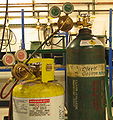Storage tank
A tank is a container, usually for liquids, sometimes for gases. Tanks can be many shapes, but large tanks tend to be cylindrical, or to have rounded corners, to easier withstand hydraulic pressure of contained liquid. See Tank (disambiguation)#Containers for more information about types of containers called tanks.
A large tank is sometimes mounted on a lorry or on an articulated lorry trailer, which is then called a tanker.
Special features
Since most liquids can spill, evaporate, or seep through even the tiniest opening, special consideration must made for their safe and secure handling.
Floating roof
Some storage tanks need a floating roof in addition to the fixed roof of the structure. This floating roof rises and falls with the liquid level inside the tank, thereby eliminating the vapor zone. Floating roofs are considered a safety requirement as well as a pollution prevention measure for many industries, including petroleum refining.
Types of tanks
High pressure
In the case of a liquified gas such as hydrogen or natural gas, or a compressed gas such as compressed natural gas or MAPP, the storage tank must be made to withstand the, sometimes immense, pressures exerted by the contents. These tanks may be called cylinders.
Milk tank
In dairy farming a bulk milk cooling tank is a large storage tank for cooling and holding milk at a cold temperature until it can be picked up by a milk hauler. The bulk milk cooling tank is an important milk farm equipment. It is usually made of stainless steel and used every day to store the raw milk on the farm in good condition. It must be cleaned after each milk collection. The milk cooling tank can be the property of the farmer or being rented to the farmer by the dairy plant.
Septic tank
A septic tank is part of a small scale sewage treatment system often referred to as a septic system,. It consists of the tank and a septic drain field. Wastewater enters the tank where solids can settle and scum floats. Anaerobic digestion occurs on the settled solids, reducing the volume of solids. The water released by the system is normally absorbed by the drain field without needing any further treatment.
Mobile "storage" tanks
While not strictly a "storage" tank, mobile tanks share many of the same features of storage tanks. Also, they must be designed to deal with a heavy sloshing load and the risk of collision or other accident. Some of these include ocean-going oil tankers and LNG carriers; railroad tank cars; and the road and highway traveling tank trucks. Also included are the holding tanks which are the tanks that store toilet waste on RVs and boats.
See also
- Ballast tank
- Irrigation tank in India. Some Indian language words similar to "tak" or "tank" mean "reservoir for water".
- BS4994: British Standard 4994:1987 specification for design and construction of vessels and storage tanks in reinforced plastics
- Fuel tank
- Oil depot
- Pressure vessel
- Underground storage tank
- Vacuum flask
- Water heating
Images
-
Oxygen and MAPP gas cylinders
-
Steel pressure vessel
-
Milk cooling tank
-
Fuel tanks
-
Septic tank
-
Tanker lorry
-
Temple stepped tank in India
Other meanings
- See tank for the armored vehicle.
- See tank (disambiguation) for other meanings.
Etymology
The word "tank" originally meant "artificial lake" and came from India, perhaps via Portuguese tanque. It may have some connection with:-
- Some Indian language words similar to "tak" or "tank" and meaning "reservoir for water".
- The Arabic verb istanqa`a = "it [i.e. some liquid] collected and became stagnant".







